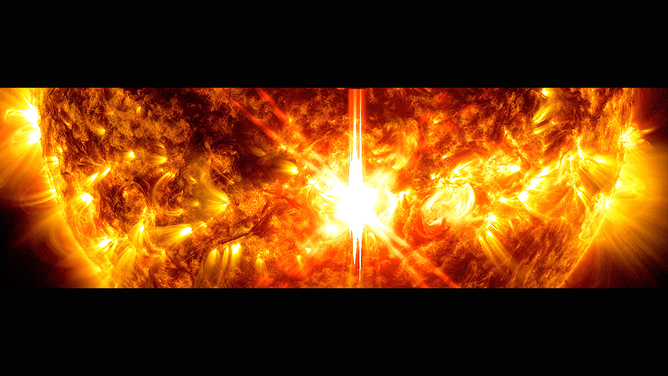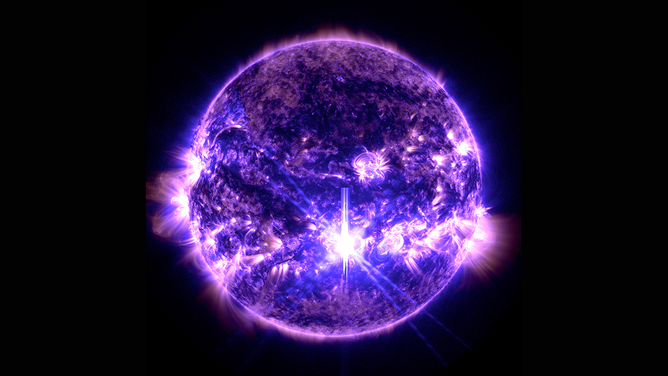Strongest solar flare in 7 years could lead to communication blackouts on Earth
The X9.0 flare takes the crown from the previous strongest flare of Solar Cycle 25, which was an X8.7 flare on May 14. A Geomagnetic Storm Watch has been issued through Sunday.
Largest solar flare in 7 years erupts toward Earth
The largest solar flare of the current solar cycle exploded Thursday, emanating from a sunspot directly facing Earth. Classified as an X-9, this is the most powerful flare of the cycle to date.
The Sun emitted the strongest solar flare in seven years Thursday, and space weather forecasters are watching to see what impacts this event has on Earth, including displays of the Northern Lights and implications for the power grid, radio communications and GPS.
NOAA's Space Weather Prediction Center (SWPC) said the X9.0 flare was seen blasting from the Sun on Thursday morning. An X flare is the most intense, and the number represents its strength. While the Sun frequently produces these bursts of energy, flares of this magnitude are uncommon.
7 THINGS TO KNOW ABOUT THE NORTHERN LIGHTS
The X9.0 flare takes the crown from the previous strongest flare of Solar Cycle 25, which was an X8.7 flare on May 14. Thursday's flare is the 15th strongest on record, reports Space Weather Watch.
At least two coronal mass ejections associated with the recent flare activity are headed toward Earth and expected to arrive in the next three days.

NASA’s Solar Dynamics Observatory captured this image of an X9.0 solar flare – as seen in the bright flash in the center – on Oct. 03, 2024. The image shows a blend of 171 Angstrom, and 131 Angstrom light, subsets of extreme ultraviolet light.
(NASA/SDO)
The Sun is approaching its solar maximum in Solar Cycle 25 – 11 years of activity marked by a crescendo of sun spots, which can lead to solar flares and more space weather events. Since May, the Sun has created its top three strongest flares of the cycle, with two of those happening this week.
GPS, HF radio signals can be impacted during solar storms
The immediate impacts of the flare include strong degradation or signal loss for high-frequency communication bands over much of the sunlit side of Earth. According to the SWPC, high-frequency radio signals may experience loss of contact or major disruptions for minutes up to a couple of hours.
During solar radiation storms of this magnitude, GPS navigation errors are likely, which could impact equipment that relies on GPS, such as tractors, as farmers experienced during May’s extreme solar storms.
What is the Northern Lights forecast for the US?
The SWPC has issued a Geomagnetic Storm Watch through Sunday after the Sun emitted an X7.1 solar flare, the third-strongest of the solar cycle, and the more recent X9.0 flare.
The SWPC rates solar storms on a five-level scale, with five being the most extreme and rarest space weather conditions.

(FOX Weather)
According to the SWPC, a pair of coronal mass ejections are forecast to begin arriving this weekend. Beginning Friday through Sunday, a period of G3 "strong" geomagnetic storming conditions is possible. These conditions could produce the Aurora Borealis or Northern Lights as far south as Iowa and across the Midwest.
Cloud cover should be minimal across much of the northern tier on Saturday night, except for some clouds in the Northeast.

(FOX Weather)
THE DAY THE NORTHERN LIGHTS COVERED THE PLANET: HISTORY OF EARTH'S GREATEST SOLAR STORMS
These stronger geomagnetic storms are less common than G1 or G2 events. However, Earth experienced near-global auroras in May, even as far south as Florida, when an "extreme" (G5) geomagnetic storm occurred because of two groups of extremely active sunspots.

NASA’s Solar Dynamics Observatory captured this image of an X9.0 solar flare – as seen in the bright flash in the center – on Oct. 03, 2024. The image shows a blend of 171 Angstrom, and 131 Angstrom light, subsets of extreme ultraviolet light.
(NASA/SDO)
With the new, stronger flare, space weather forecasters told FOX Weather that it's "very likely" that it has Earth-directed components.
A pair of coronal mass ejections are expected to arrive over the next three days, and the current Geomagnetic Storm Watch could be extended or upgraded to a warning.
If the SWPC forecasts a severe (G4) Geomagnetic Storm, the Northern Lights could be visible as far south as the Carolinas.
Stay with FOX Weather for the latest space weather forecasts and updates on this developing story.
